Yabraq
April 20th, 2010

Last year I posted Yalanji (stuffed grape leaves), and today’s post is about Yabraq which is also stuffed grape leaves, the differences between Yalanji and Yabraq are:
Yalanji: The filling is rice and vegetables, the size of the grape leaf that is used is large, and the rolled leaves look thick.
Yabraq: The filling is rice and meat, and cooked in lemon juice, the size of the grape leaf that is used is medium and small, and the rolled leaves look thin and tall like cigarettes.
Let’s make Yabraq:
Before talking about the method of cooking Yabraq, I’ll tell you some information about two things:

1. Grape Leaves:
Read all the notes about grape leaves in the post (Waraq Al-E’nab).
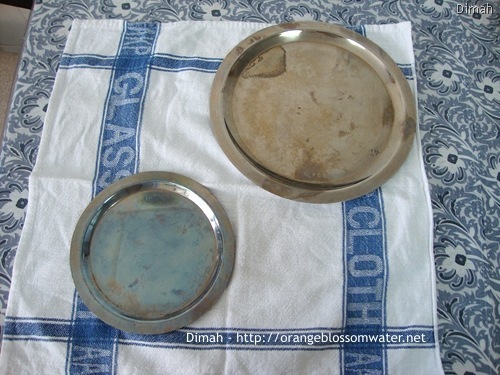


2. Stainless Steel Pot Lid (I will give it the name “Flat Pot Lid”)
This lid is needed for the technique of cooking “Yabraq”, anything looks like this lid works fine, just try to find something similar to it. I have two sizes a big one and small one as you can see in the picture, I will not use both of them, you will know more in the rest of the post.
Let’s make Yabraq:

1. You can see in the picture Grape Leaves, these are frozen at home.
2. In pot, put water and bring to boil.
3. Once water is boiling, turn off heat, then add the stack of grape leaves to water, and keep for 10 minutes.
4. Place the stack on a stainer or colander to drain, and set aside.

Filling
5. In the bowl, you can see fat free lamb meat, and Sheep/Lamb tail fat, in Syria the sheep/lamb tail fat is called “Liyeh”.
6. Prepare meat grinder, attach the fine holed plate.
7, 8. Grind the meat and the liyeh together, and set aside.

9. This Egyptian rice.
10. Rinse rice with cold water in several changes.
11. Bring water to boil.
12. Soak rice in boiled water for 10 minutes, then drain and rinse with cold water in several changes.

13. To rice, add the mixture of ground meat and liyeh.
14. Add salt and black pepper, don’t add salt directly to rice, but add it directly to the mixture of meat and liyeh.
15, 16. Mix until combine.


Roll the Grape Leaves
The steps from 17 – 24 show you how to roll.
Choose the leaves that are medium size and small size.
The filling is added to the side where the veins of the leaves are most prominent.
Picture 18, the quantity of the filling is 1/2 teaspoon. You should notice that in Yabraq, the amount of filling added to each leaf is between 1/2 teaspoon to 3/4 teaspoon, according to the size of the leave, but don’t add more than that.
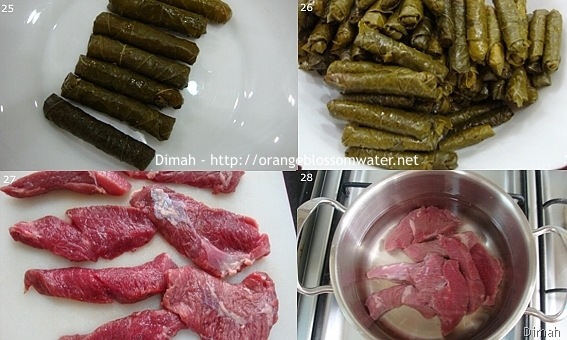
25, 26. Make all the quantity, and set aside in the refrigerator.
Cooking Meat
27. This is fat free boneless lamb meat from the leg.
28. Put the meat in pot and cover with water.

29. Turn on heat, and keep until boil and a foam occur on surface.
30. Once the foam is formed, you can see it very clearly, take the pot and put under water so all the foam is washed and removed.
31, 32. Put the meat in a pot, and cover with water and add salt, then cover the pot with a lid and cook the meat on medium heat for 30 minutes, then turn off heat, drain and set aside.

Cooking stuffed grape leaves
33. Prepare lemon juice, and set aside.
34. Prepare garlic cloves, and set aside.
35. In pot, put 3 liter water, and bring to boil.
36. Meanwhile, bring a large deep pot, and arrange tablespoons (it doesn’t matter how they are arranged, try any way you are comfortable with, also 4 tablespoons were good for the size of my pot).

37. Add the flat lid over the tablespoons (I used the small pot lid because the size is perfect for my pot). The tablespoons and the pot lid work as a protection for the stuffed grape leaves; to prevent the direct contact between the stuffed grape leaves and the heat.
38. Add unrolled grape leaves (I used 2 grape leaves) over the flat lid.
39. Arrange the meat over the unrolled grape leaves.
40. Add 50 ml of lemon juice, and add pinch of salt, (The whole amount of Lemon juice is 300 ml and it will be added one by one in each layer).

41. Add some of the garlic cloves, (The garlic cloves are 25 cloves, and they will be added one by one in each layer).
42. Arrange the first layer of stuffed grape leaves, the same way as you see in the picture.
43. Add lemon juice about 100 ml, and add pinch of salt.
44. Add some of the garlic cloves.

45. Arrange another layer of stuffed grape leaves, add lemon juice (about 100 ml), add pinch of salt, add garlic cloves, then arrange another layer and do all the steps until you finish all the stuffed grape leaves and lemon juice and garlic cloves, when you finish the last layer, add 1/4 tsp of lemon salt to the pot.
46. Add unrolled grape leaves over the last layer of stuffed leaves.
47. Put a plate over thegrape leaves.
48. Add a heavy thing over the plate, this is a piece of marble.

49. Add boiling water (water in picture 35).
50. Keep on high heat until it starts to boil vigorously.
51. Once boiling vigorously, lower the heat, also taste and if it needs salt so you can add salt.
52. This picture shows that the heat should be very low (the lowest heat).

53. Cover the pot with the lid, and cook on the lowest heat for 2 hours.
54. After two hours, turn off heat, it is time to serve.
55. Remove the heavy piece.
56. I use “pot strainer” to help me to pour out the cooking water through the strainer.

57. Pour out the cooking water through the strainer.
58. Save the cooking water, to serve with the grape leaves.
59. In the pot, the stuffed grape leaves.
60. Bring a serving plate that fit the size of your pot.

61, 62. Flip the stuffed grape leaves onto the serving plate.
63. The grape leaves are ready to serve, you can notice the meat on top.
64. Serve Yabraq with the cooking water (it has the taste of lemon juice), the garlic cloves (was cooked with the stuffed leaves), yogurt, and Arabic flat bread.

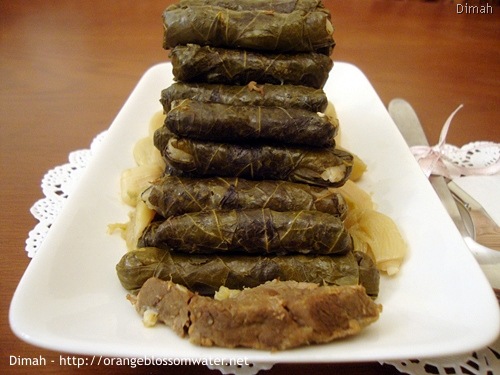
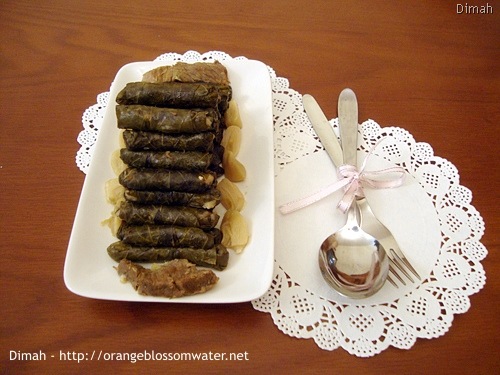

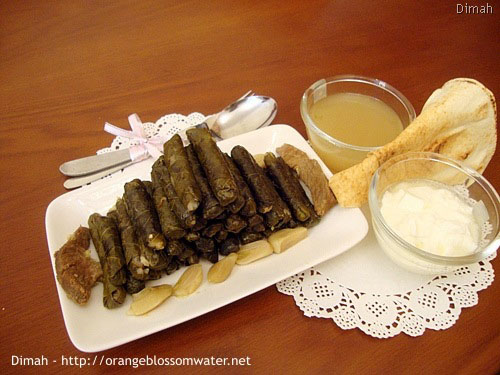
Yabraq
From: Family Recipe / Servings: 7 – 8 People
PDF Text Only / Print With Images
| 190 g grape leaves, medium and small size Boiling water, for grape leaves Filling 100 g fat free lamb meat 150 g sheep/lamb tail fat “Liyeh” 400 g Egyptian short grain rice Boiling water, for soaking rice 2 1/2 tsp salt 1 tsp black pepper Cooking Meat 500 g fat free boneless lamb meat, Water Salt Cooking stuffed grape leaves 300 ml lemon juice 25 garlic cloves 3 L boiling water Additional grape leaves, not rolled (explained in the directions) Salt 1/4 tsp lemon salt (citric acid) |
You can see in the picture grape leaves, these are frozen at home. In pot, put water and bring to boil.Once water is boiling, turn off heat, then add the stack of grape leaves to water, and keep for 10 minutes. Place the stack on a stainer or colander to drain, and set aside. Filling In the bowl, you can see fat free lamb meat, and Sheep/Lamb tail fat, in Syria the sheep/lamb tail fat is called “Liyeh”. Prepare meat grinder, attach the fine holed plate. Grind the meat and the liyeh together, and set aside. This Egyptian rice. Rinse rice with cold water in several changes. Bring water to boil. Soak rice in boiled water for 10 minutes, then drain and rinse with cold water in several changes. To rice, add the mixture of ground meat and liyeh. Add salt and black pepper, don’t add salt directly to rice, but add it directly to the mixture of meat and liyeh. Mix until combine Roll the Grape Leaves The steps from 17 – 24 show you how to roll. Choose the leaves that are medium in size and small in sizes. The filling is added to the side where the veins of the leaves are most prominent. Picture 18, the quantity of the filling is 1/2 teaspoon. You should notice that in Yabraq, the amount of filling added to each leaf is between 1/2 teaspoon to 3/4 teaspoon, according to the size of the leave, but don’t add more than that. Make all the quantity, and set aside in the refrigerator. Cooking Meat This is fat free boneless lamb meat from the leg. Put the meat in pot and cover with water. Turn on heat, and keep until boil and a foam occur on surface. Once the foam is formed, you can see it very clearly, take the pot and put under water so all the foam is washed and removed. Put the meat in a pot, and cover with water and add salt, then cover the pot with a lid and cook the meat on medium heat for 30 minutes, then turn off heat, drain and set aside. Cooking stuffed grape leaves Prepare lemon juice, and set aside. Prepare garlic cloves, and set aside. In pot, put 3 liter water, and bring to boil. Meanwhile, bring a large deep pot, and arrange tablespoons (it doesn’t matter how they are arranged, try any way you are comfortable with, also 4 tablespoons were good for the size of my pot). Add the flat lid over the tablespoons (I used the small pot lid because the size is perfect for my pot). The tablespoons and the pot lid work as a protection for the stuffed grape leaves; to prevent the direct contact between the stuffed grape leaves and the heat. Add unrolled grape leaves (I used 2 grape leaves) over the flat lid. Arrange the meat over the unrolled grape leaves. Add 50 ml of lemon juice, and add pinch of salt, (The whole amount of Lemon juice is 300 ml and it will be added one by one in each layer). Add some of the garlic cloves, (The garlic cloves are 25 cloves, and they will be added one by one in each layer). Arrange the first layer of stuffed grape leaves, the same way as you see in the picture. Add lemon juice about 100 ml, and add pinch of salt. Add some of the garlic cloves. Arrange another layer of stuffed grape leaves, add lemon juice (about 100 ml), add pinch of salt, add garlic cloves, then arrange another layer and do all the steps until you finish all the stuffed grape leaves and lemon juice and garlic cloves, when you finish the last layer, add 1/4 tsp of lemon salt to the pot. Add unrolled grape leaves over the last layer of stuffed leaves. Put a plate over thegrape leaves. Add a heavy thing over the plate, this is a piece of marble. Add boiling water (water in picture 35). Keep on high heat until it starts to boil vigorously. Once boiling vigorously, lower the heat, also taste and if it needs salt so you can add salt. This picture shows that the heat should be very low (the lowest heat). Cover the pot with the lid, and cook on the lowest heat for 2 hours. After two hours, turn off heat, it is time to serve. Remove the heavy piece. I use “pot strainer” to help me to pour out the cooking through the strainer. Pour out the cooking water through the strainer. Save the cooking water, to serve with the grape leaves. In the pot, the stuffed grape leaves. Bring a serving plate that fit the size of your pot. Flip the stuffed grape leaves onto the serving plate. The grape leaves are ready to serve, you can notice the meat on top. Serve yabraq with the cooking water (it has the taste of lemon juice), the garlic cloves (was cooked with the stuffed leaves), yogurt, and Arabic flat bread. |
Notes and Tips
Some people like to make the mixture of meat and liyeh coarser, but in my family we like them very fine.
Some people substitute sheep/lamb tail fat “Liyeh” with oil or ghee or butter, actually that will not be a traditional yabraq, and the taste is not great at all, liyeh gives yabraq the unique taste.
In Syria, we don’t add cinnamon, cloves, all spice or any spice to any kind of dish except in few case and that’s when the recipe specifies the spices such as in Ozee, so please don’t add any spices if my recipe didn’t tell you to add, otherwise you will not get the traditional taste. Yabraq doesn’t need any spices, and that’s very clear in the recipe.

I’ve never had that version (only the vegetarian version). A fabulous dish that I’ll have to make someday…
Cheers,
Rosa
Dimah
Your work is outstanding and so pro! I have been a long long time without these grape leaves, and looking at your post, I miss them!
This looks wonderful, Dimah! I’ve had something similar, but without meat. It was delicious–your version sounds amazing.
This looks wonderful! I’ve never seen this dish before but I can really imagine how delicious it would taste from the pictures :D
This is so great to know how you make them – thanks!
This is new to me but looks delicious. Thanks for showing the steps.
Oh Dimah, I love stuffed grape leaves…love the information on your post :-)
These look like great finger food, and I bet I could make them with tempeh instead of meat, too. Perhaps for future parties or potlucks!
Rosa: Thanks for coming by!
tasteofbeirut: Thank you!
lisa: Thanks for stopping by!
Lorraine @Not Quite Nigella: Thanks!
SimplyLife: Thanks!
MaryMoh: Thank you!
Juliana: Thank you!
Hannah: Thanks for visiting!
Not sure why I did not find this earlier, but I wanted to let you know how much I enjoyed this post. Researching Syrian food, I was checking out Yabraq – and your post came up. So thorough and detailed – absolutely love it! I cannot wait to make both yabraq and yalanji and compare and contrast!
Oh, I love it. I never tried to make them myself, no grape leaves here… but I always enojoy when we get ready ones :)